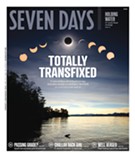Published January 7, 2009 at 6:49 a.m.
Each January, journalists everywhere pull out their crystal balls, give them a good dusting, and attempt to predict what will be hot — or not — over the next 12 months. Food writers are no exception. Newspaper restaurant critics, taste makers at glossy magazines and well-known chefs all spend the lead-up to New Year’s chewing over what may be popular on people’s tables in the months to come.
This year, those lists are crowded with references to the tough economy. Gone are the luxurious pleasures of yesteryear, such as Kobe-beef burgers topped with oozing slabs of seared foie gras and $1000 desserts sprinkled with gold leaf. In their place are practical — and affordable — notions.
Gourmet magazine’s culture vultures, for example, predict an uptick in ethnic restaurants that serve flavorful fare made from inexpensive ingredients: think Korean and Indian. They also anticipate increased interest in hefty legumes such as “jumbo butter beans.” Bon Appétit says homey peanut butter desserts and “anything with an egg on top” will sell well. Frugal is in.
One upside of the downturn is that Vermont, with its practical cuisine based on locally grown and produced foods, is turning out to be a leader rather than a follower. In past years, the lack of luxe ingredients on Green Mountain menus made some urbanites label our eateries as less than hip. But now that big-city chefs are jumping on the locally grown bandwagon, doing “nose-to-tail” dinners and braising cheaper cuts of meat to tender perfection, our chefs look positively revolutionary.
Not everyone is buying the farm-to-table trend — take John Cloud of Time Magazine, who seems to be feeling a tad cynical. Although most predictors are guessing that localvore dining will be a scorching success in 2009, he thinks the backlash against it will be even hotter. Cloud suggests that the massive refrigerated trucks criss-crossing the country may be “more carbon-neutral than your local farmer’s pickup.” But keep in mind that he’s also the guy who’s calling a deadly strain of foodborne illness, Salmonella Saintpaul, a “top 10 trend.”
We may not be as cranky as John Cloud. But here at Seven Days, we have our own brand of trend prediction, one that relies less on doom and gloom than on our favorite dish: tongue in cheek. Forthwith, here are some not entirely earnest predictions . . .
Humdrum Homestyle
Savvy restaurateurs will seek to soothe the nerves of stressed-out baby boomers — who see their dreams of leisurely golf games and condos in Florida slipping away —with meals that hark back to the comforting fare they ate as children.
Folks tired of pretending to enjoy “crisp tender” vegetables and tuna that’s been cooked just long enough to stop thrashing will love the new menus inspired by vintage Betty Crocker cookbooks and the oh-so-trendy series “Mad Men.” They’ll include side dishes such as “Carrots Reduced to Mush” and “Broccoli à la Velveeta,” as well as tempting main courses like “Shoe-Leather Sirloin” and the colorless “Fish Brick.” Bread baskets will be filled to the brim with Wonder Bread and foil-wrapped pats of margarine.
On particularly busy nights, don’t be surprised to see canned peas or frozen Salisbury steak on special.
Pan-Asian Confusion
If you want to find a spicy bowl of Massaman curry or a serving of salmon sashimi in Chittenden County, you don’t have to look far. Over the past few years, the number of Asian restaurants in Vermont’s most populous region has exploded. As of 2008, the greater Burlington area alone boasts six Vietnamese joints that dish up vermicelli noodles and fish sauce.
Accordingly, the Burlington City Council has decided it’s time to institute a program of affirmative action for less well-represented ethnic cuisines. Despite growing populations of immigrants from Africa and the Himalayas, greater Burlington still offers nowhere to dine on slightly sour Ethiopian injera wrapped around flavorful goat stew, or Tibetan momos and black tea with a dollop of yak butter.
This year, the council will spring into action and staunch the flow of pho by implementing restaurant quotas: No permits will be issued for new Asian eateries until folks from the other relevant regions are represented. After all, shouldn’t a city’s restos reflect its actual ethnic makeup?
This should leave the door wide open for anybody who wants to revive traditional Anglo-Irish-Scottish cuisine —spotted dick, kidney pie, treacle pudding and the like. And one can only hope some of those Addison County farm workers from south of the border will get their green cards, move to town and open authentic Mexican restaurants.
Mobile Madness
In 2008, the Vermont Agency of Agriculture assisted farmers by premiering two traveling stations that allow food processing to happen right on the farm. In August we got the nation’s first roving “quick-freeze unit,” designed for fresh produce such as tomatoes, berries and corn. It allows farmers to reduce waste and sell the fruits of their fields all year round. The second innovation, a “poultry slaughtering facility,” arrived in November and can deal out death to 200 birds per day.
In 2009, expect the ag department to follow up on these successes with a squadron of mobile units designed to make life even easier for the hardworking folks who produce Vermont’s food.
With area chefs eager to serve delicious and affordable cured meats made from the flesh of locally raised animals, but so few farmers versed in the art of making charcuterie, the ag agency is proud to offer its very own traveling “Sausage Party.” Schedule a stop on slaughtering day, and the van’s staff will turn your pork bellies into bacon and your animal blood into “black pudding.” Haggis available on request.
The facility features hot and cold smokers, an industrial-sized meat grinder and a fine selection of dried herbs and spices.
Finally, after pleas from area animal shelters, the ag agency has conceived a traveling “Rodent Elimination” unit, which serves the dual purpose of employing out-of-work pet cats and keeping farmers’ barns squeak-free. Each feline on the team gets her own kitty condo, and every month, the most successful mouser is gifted with a lifetime supply of ’nip from a farm in the Northeast Kingdom.
Slaughterhouse Sightseeing
Struggling Vermont “processing plants” are notorious for avoiding the press and not welcoming visitors, but all that will change in 2009. Sure, vegetarians may call ’em giant killing machines, but our slaughterhouses have undeniable localvore cachet.
In an attempt to gain positive name recognition in their communities, meat packers will band together and follow in the footsteps of the state’s artisan cheesemakers when they print a full-color map of the brand-new “Vermont Slaughterhouse Trail.”
Tourists and locals alike will appreciate the map’s animal identification border. A handy chart includes hours of operations for each participating business, so you won’t show up at the wrong time.
Getting the Runs
Last year, Shoreham was the proud host of the state’s first culinary bike trek. Called the “Tour de Farms,” the ride began and ended at the Shoreham Inn, and took in stops at dairy and vegetable farms, orchards and bakeries. With 10-, 25- and 30-mile routes to choose from, exercisers of all levels could participate.
But a few hard-core athletic foodies think a bike ride — let alone with a 10-mile option — is for wimps. In May, they plan to kick it up a few notches with the nation’s first ever Eat-and-Run-athon. The gut-wrenching ordeal will force folks to gulp down local wines, wedges of goat cheese and piles of fresh heirloom vegetables while competing to finish a 26-mile course on rutted back roads.
Runners won’t be expected to stop to pet cows or speak to the suppliers. They’ll grab paper cups stuffed with free samples from farmers along the way. Reverse peristalsis ensures there’ll be room for dessert.
Community-Supported . . . Whatever
One of the hottest trends of the recent past is a food subscription of sorts, where consumers pay up front for services they’ll receive in small increments over time. Referred to as the “community supported” business model, this practice has helped small farms, bakeries, restaurants and even seed companies thrive. At Pete’s Greens in Craftsbury, for example, customers pay in advance for 18 weeks’ worth of produce and a variety of local goods such as flour, cheese, oil, eggs, dried beans and cider. The Backdoor Bakery in Huntington offers a similar arrangement that keeps its sweet-toothed customers happy with cakes and cookies.
This year, enterprising private citizens are seeking ways to turn the model to their own advantage. Don’t be surprised if you hear proposals from your friends and coworkers about how some of their efforts could be bolstered by the community, too.
CSC, or “community-supported cleaning,” is just one example. “Our fridge at work is totally gross, and nobody at the office ever pitches in to help,” muses Beatrice Coffer, a cubicle monkey at an area bank. “Two weeks ago I noticed stinky shrimp Pad Thai leftovers and fuzzy cream cheese, and both of them are still in there.” Coffer is asking each coworker to pay her $10 up front in exchange for her pledge to keep the fridge spiffy with a monthly cleaning.
Asked what she’ll do with the $320 income supplement, Coffer says she’ll invest in rubber gloves, a face mask and a bottle of vodka. The rest will be “pure profit.”
Another local resident, Keith Forme, plans to turn his backyard garden into a CSA venture. “If my neighbors give me some money to buy seeds, fertilizer and gardening tools, I’ll totally toss some zucchini their way if I have extra,” he enthuses.
A Little Bit of This, A Little Bit of That
Speaking of CSA shares . . . The practice of supplementing the usual tomatoes and zucchini with “add-ons” will also expand in imaginative directions in the coming months. Right now, you may not expect to find non-food items in your basket. But, as anyone who attends a farmers’ market knows, there are plenty of local soap makers, candle dippers, bead stringers and knitters of scarves and toilet-paper dolls who are eager for a market. Inventive new CSA “packages” will allow you to sample their wares.
And what about the local indie video stores striving to compete with Netflix? Their daring new strategy involves putting popular movies in CSA boxes. Will you be watching Hellboy II or Twilight? You won’t know until you get to the farm.
Steeling the Iron Chef
Last year, numerous nonprofits jumped on the “Iron Chef” bandwagon and staged their own fundraising versions of the hit TV show, pitting local food-slingers against one another in timed competitions. It’s a fun way of supporting a cause, but to keep the concept fresh, some planners have decided to start raising the steaks . . . um, stakes.
In 2009, chefs who enter and lose an “Iron Chef”-style competition will be banned from local kitchens for a full year. “To keep people coming, we really need competitors to put something vital on the line,” says Shelburne philanthropist Emily Bienfaire. “When the chefs aren’t fully engaged in the competition, how can we expect the audience to get that excited?”
Rumor has it some chefs think the penalty is a bit harsh, especially when they’re donating their time to participate, but Bienfaire disagrees. “On ‘Top Chef,’ losers get humiliated in front of a national audience. We Vermonters would never skewer someone’s career that way,” she says. “If they’re smart, they’ll use the year off to sharpen their skills somewhere they’re not blacklisted.”
It’s certainly an improvement over the ancient Mexican game of Tlatchtli, in which a competitor was beheaded at the end of every match.
More By This Author
About the Artist

Michael Tonn
Bio:
Michael Tonn is still just eating gummy bears outside the Shopping Bag in Burlington. To see more of his work and to get in touch, go to michaeltonn.com or @dead_moons on Instagram.
Michael Tonn is still just eating gummy bears outside the Shopping Bag in Burlington. To see more of his work and to get in touch, go to michaeltonn.com or @dead_moons on Instagram.
Speaking of Food, humor
-

Q&A: Howard Fisher Delivers Meals on Wheels With a Side of Good Cheer
Dec 20, 2023 -

Video: Howard Fisher Delivers Meals on Wheels
Dec 14, 2023 -

Q&A: Alexis Dexter Rescued 57 Shelter Cats During the July Flood
Sep 13, 2023 -

Video: Two Months After the Flood, Alexis Dexter Rebuilds Kitty Korner Café in Barre and Continues to Rescue Cats
Sep 7, 2023 -

Video: Saying Goodbye to Burlington’s Penny Cluse Café
Nov 17, 2022 - More »
Comments
Comments are closed.
From 2014-2020, Seven Days allowed readers to comment on all stories posted on our website. While we've appreciated the suggestions and insights, right now Seven Days is prioritizing our core mission — producing high-quality, responsible local journalism — over moderating online debates between readers.
To criticize, correct or praise our reporting, please send us a letter to the editor or send us a tip. We’ll check it out and report the results.
Online comments may return when we have better tech tools for managing them. Thanks for reading.















































